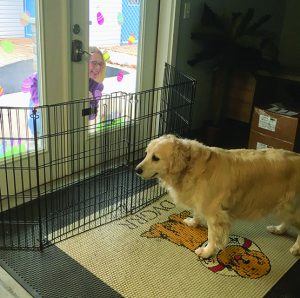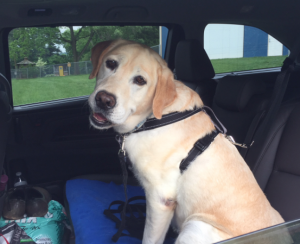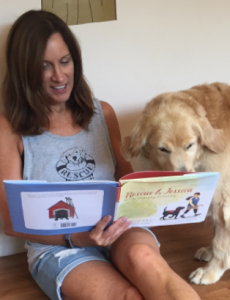 Giving Your Dog Space
Giving Your Dog Space
Many people feel that for shy/fearful/skittish dogs, “all they need is love.” They do need love, but in the beginning, they may need a lot of space. They are in a new home, a new environment with a new family, and it takes time for them to adapt and learn to trust their new adopters. Be patient with them. Do not force human contact, they will accept it on their own as they are ready. Do not corner or hover over them as it is threatening. Remember that dogs have a fight or flight instinct when feeling trapped. You want your new companion to have good experiences with humans – something many of them have not had in the past. So go slow and understand that progress will happen gradually. Remember not to invite a lot of family and friends over for the first few weeks and to give your dog quiet time in their safe zone where they can retreat and relax and have some down time.
When first interacting with your new dog, keep things quiet and gentle. Do not have a lot of noises such as television, music, computer games, etc. happening at the same time. Remember the phrase “low & slow.” Sit on the floor if possible to make yourself less threatening. Sitting in a chair is okay, too. All new activities and situations should be introduced slowly.
![]()
 Keeping Your Dog Safe – Preventing Escape
Keeping Your Dog Safe – Preventing Escape
Over the years, we have had a few of our adopted dogs go to live in their new homes and, due to being nervous, have bolted through doors whether that be from a car door or a door in the house that leads to an unfenced area. A nervous dog can bolt out the slimmest door opening before you even realize it! Some dogs went missing for hours, days, or weeks, and a couple never made it back home because they were hit by vehicles and killed. This is extremely sad but bluntly true and not meant to scare you – instead, we want to prepare adopters so you can keep your dog safe and not have to endure the trauma others have gone through.
We require physically fenced yards for most of these types of dogs. So what should you do when you want to use a door that leads to an unfenced area? You may be leaving for work, opening the door for a guest or delivery person, or simply going out to get the mail. Most front doors are used for this purpose. You could purchase an x-pen or wide gate and surround your front door with it so that when you leave, you enter the x-pen and close it behind you – then leave through your door. You could purchase a baby gate and gate the dog in a room away from the door – as long as your dog can’t/won’t jump the gate or knock it over! If your dog likes a crate, you could crate the dog before exiting. You could also choose to make those particular doors off limits. We have had adopters post brightly colored signs on those doors warning guests to be cautious when arriving and to enter swiftly instead of holding the door open for a lengthy period of time. If your dog is comfortable with the leash, clip a leash to them before opening the door for a guest. Remember that skittish dogs are very quick and will bolt out before you even realize that it happened. Having your home prepared before bringing your dog home will help manage this situation.
The same goes for car doors. At DVGRR, we have harnesses and seat belt attachments that we can provide to you. These harnesses and seat belts are not crash tested; instead they are used to prevent your dog from bolting out the car door when opened and even from squeezing out of a window cracked for air – yes, it has happened quite a few times! We advise to put your air conditioning on instead of rolling down the windows. These dogs have typically not ridden in cars so many take the opportunity to escape if available.
![]()
 Car Safety
Car Safety
Most mill dogs and breeder dogs have not had the experience of riding in a car. We have heard unpleasant stories of skittish dogs escaping from cars and running away, getting hurt, or worse. We highly suggest having a secure method to keep your dog safe when traveling. As mentioned, we recommend using a harness with a seatbelt attachment. (Remember that you should never attach a seatbelt to a dog’s collar. If you were to get into an accident or slam on your brakes, they could be injured if tethered around their neck.) This way, when you open the car door to retrieve your dog, the dog is secure and cannot bolt out the door. When reaching your destination, turn and check that your dog is still secure and make sure the dog has not chewed through the leash or harness. Ideally, if there is more than one person in the car, have someone hold the leash before opening the car door.
Getting in and out of the car can be very scary for your dog at first. Because of your dog’s inexperience, do not expect them to immediately trust jumping into a car. You will most likely have to assist your dog into the car by lifting the dog. If they are afraid of approaching the car, you will first need to work on desensitizing them gradually to being near the car. For more help, research online articles on desensitization and counterconditioning by one of our recommended experts at the end of “Continuing the Journey.”
![]()
Daily Routine
Maintaining a daily routine is so important in the beginning when your dog is first learning to live with you. Take them outside, feed them, play with them, give treats, go for walks at approximately the same time and in the same order every single day to the best of your ability. Do this so that your dog will begin to know what to expect every day. When your dog knows what to expect, their fear will lessen day by day.
![]()
 Reading Books and Talking to Your Dog
Reading Books and Talking to Your Dog
Reading books to dogs may sound silly, but we have noticed it helps some of them relax. In Project Home Life, we choose to read children’s books, and our favorite topic is dogs, of course!
Talk with a voice that is natural – a soft and steady voice while reading and practice intermittently giving the dog eye contact between pages. Shy dogs respond better to soft, happier tones versus loud, deep authoritative tones. If the dog is comfortable being petted, feel free to do so while reading. If the dog enjoys treats, try putting a few in your hand and randomly give the dog a treat during the course of the book. This activity helps with bonding by getting the dog familiar with your voice in a low-pressure situation.
![]()
Noises Around the House
Since puppy mill breeder dogs have rarely lived in a home, they are unfamiliar with many of the everyday noises that occur there. Doorbells, vacuum cleaners, clattering dishes – it’s all new to them and can be very scary.
If the dog is startled by a sudden noise, we recommend not bringing undue attention to the noise. Act as if it’s no big deal and redirect them to something positive, such as a toy, treat, or something else they may enjoy. If they see another dog in the home acting nonchalant during the noises, that will help greatly as well.
We find that getting accustomed to noises around the house simply takes time.
For help with noises such as thunderstorms and fireworks, please refer to
our website under the Education tab and look for the article “Thunderphobia in Dogs”.

